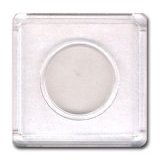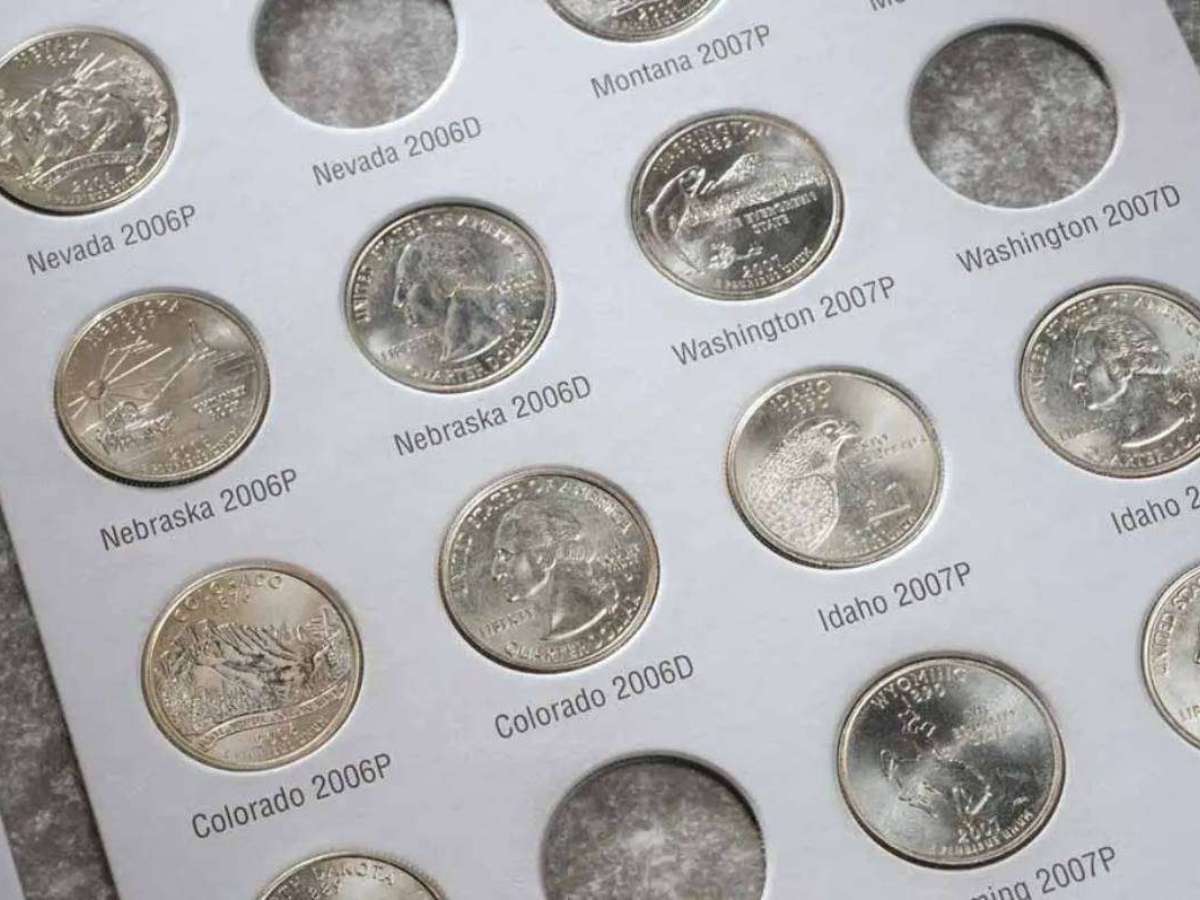Proper coin storage is a necessity if you want to eventually get the most money for the coins in your collection.
You don’t want those prized coins getting scratched and marred up.
So what’s the best way to store coins and keep them safe?
Should you use coin holders?… Mylar protectors?… Coin albums?… Coin tubes?… Coin binders?… AirTite holders?… Coin slabs?… or even Zip-type baggies?
Here are some tips for storing the coins in your collection…
Which Method Is Best?
There are actually several coin storage solutions on the market today. All are adequate, some being better than others.
The type of storage you select has a lot to do with the type of coins you’re collecting.
For example, if you just have a few old banged up wheat pennies, then you’re probably not going to want to go out and purchase an expensive Intercept wheat cent album.
On the other hand, if you collect flying eagle cents, you’re probably not going to store them in coin tubes.
Here’s a run-down of the various methods of storing coins, including when you might choose one method over the other:
2×2 Cardboard Holders
 These are probably the cheapest way to store coins — other than tubes and rolls. Cardboard coin holders are actually 2×8 pieces of cardboard with 2 coin-sized holes cut out and covered with plastic which forms a “window” around the coin.
These are probably the cheapest way to store coins — other than tubes and rolls. Cardboard coin holders are actually 2×8 pieces of cardboard with 2 coin-sized holes cut out and covered with plastic which forms a “window” around the coin.
You place your coin on the plastic of one of the holes and then fold the contraption in half, which brings the other “window” down on the reverse side of the coin. When you have it positioned where you want it, you staple it on all four sides surrounding the coin window to secure it in place.
This method of storage is very inexpensive — only like a buck or 2 for 25 of them. However, the plastic “windows” on these coin holders is very thin. It does prevent some wear and tear on the coins, but you probably don’t want to put extremely high quality coins in cardboard holders.
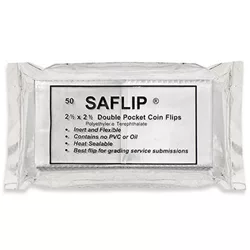
2×2 Mylar Coin Flips
Mylar flips are a step up from the cardboard holders, and they are more protective of the coins.
There is no cardboard at all on these. They also contain no PVC or oil. They are a high-quality plastic looking material — like the pages of a baseball card binder are made of.
I’d recommend these if you want to store some low-value coins that you plan on selling eventually.
2×2 Plastic Snap Holders
One step up from the mylar holders, plastic 2×2 coin holders are made of hard plastic instead of the softer mylar type material.
You place your coin in between the 2 plastic panels and then snap them together to secure the coin in place.
These can be a good way to store your more valuable ungraded coins.
Coin Albums
This is probably one of the most common ways to store coins. If you’re putting together a set — such as walking liberty half dollars or Lincoln wheat cents — coin albums are an ideal method for storing your collection.
There are a few different types of coin albums. Here are the differences:
 The more common (and less expensive) Whitman albums and Harris folders fold out into 3 or 4 sections and usually have multiple slots for each year. That way, you can put in one coin of each mintmark. This is okay, but you kinda have to push down hard on the coin and apply some force to get them to lock nicely in place. And then, even once you get them in, only one side of the coin is viewable. You can pick these up for a couple of dollars. If you’re putting together a cheaper circulated wheat cent collection, or something similar, then the Whitman and Harris albums will do fine.
The more common (and less expensive) Whitman albums and Harris folders fold out into 3 or 4 sections and usually have multiple slots for each year. That way, you can put in one coin of each mintmark. This is okay, but you kinda have to push down hard on the coin and apply some force to get them to lock nicely in place. And then, even once you get them in, only one side of the coin is viewable. You can pick these up for a couple of dollars. If you’re putting together a cheaper circulated wheat cent collection, or something similar, then the Whitman and Harris albums will do fine.- The better coin albums such as Intercept are quite a bit more expensive ($20.00 – $30.00), but well worth the money. Instead of folding out into sections, these actually have thick cardboard pages. There are all the appropriate slots for the dates and mints like in the Whitman albums, but with these there’s no pushing and forcing of the coins necessary. Plus, they display both sides of the coins nicely. To the right, where the book opens, there are plastic slides that run through the centers of the thick cardboard pages. When you pull a slide out, it opens up the slots to place the coins in. Once you have placed your coins, you simply slide the slide back in to secure the coins in place.
Coin Tubes
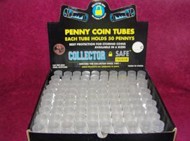 These are best for lower-grade mass storage of coins. Coin tubes are exactly what they sound like, plastic tubes that you insert your coins into with a lid that screws on and off.
These are best for lower-grade mass storage of coins. Coin tubes are exactly what they sound like, plastic tubes that you insert your coins into with a lid that screws on and off.
Why buy coin tubes? Say you have several hundred common wheat pennies. You can either throw them in a zip-type baggie or stack them nicely in coin tubes. Or, what I use them for is this… I hoard all the silver I get my hands on. So all of the circulated low grade 90% silver coins I come across — like mercury dimes, pre-1965 Roosevelt dimes, pre-1965 quarters, etc. — I throw into the coin tubes.
Yeah yeah, you can buy the cheapo paper tubes from Walmart and they serve the same purpose, but the plastic coin tubes are cooler!
Coin Binders
 Coin binders turn the cheap 2×2 cardboard holders into a good way to store coins. They are 3-ring binders that you can insert plastic pages into that hold up to, I believe, 20 coins per page. Pages are sold separately of course, but they’re not terribly expensive.
Coin binders turn the cheap 2×2 cardboard holders into a good way to store coins. They are 3-ring binders that you can insert plastic pages into that hold up to, I believe, 20 coins per page. Pages are sold separately of course, but they’re not terribly expensive.
Each page you purchase for the binder has 20 “pockets”. In each pocket, you insert one of the 2×2 cardboard holders mentioned earlier that are housing your coins. This gives the cheap cardboard holders with thin plastic a lot better protection, and becomes a great way to display your coins.
You can also pick up a cheap 3-ring binder at Walmart to put the pages in, but make sure you get a hard back — not one of the flimsy plastic backs.
AirTite Holders
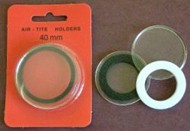 I like these the best for valuable coins that aren’t in one of my sets. AirTite holders are kind of like the 2×2 hard plastic holders, only a little better and they’re round like the coin instead of square.
I like these the best for valuable coins that aren’t in one of my sets. AirTite holders are kind of like the 2×2 hard plastic holders, only a little better and they’re round like the coin instead of square.
AirTite holders have the two round pieces of plastic that you place your coin in between and then snap together. But they also have a rubber ring designed for each type of coin. The rubber ring fits around the coin to make it a perfect fit in the AirTite holder.
This is a good safe way to store your more valuable coins and you can pick up a box of 50 for about $30.
Coin Slabs
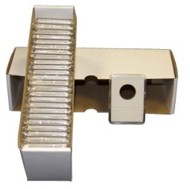 “Slab” is coin collector terminology. Generally a “slab” is what a professional grading service puts your coin into after they have given it a grade. This is the best and safest way to store coins (well…other than a 3 foot thick vault).
“Slab” is coin collector terminology. Generally a “slab” is what a professional grading service puts your coin into after they have given it a grade. This is the best and safest way to store coins (well…other than a 3 foot thick vault).
You can buy slabs online or at a coin shop. They are made of thick plastic that snaps together like the 2×2 holders. Only with a slab, they are rectangle-shaped with a space (before you snap it together) to insert a label describing what type of coin is going to be displayed in it, along with its value, or whatever info you want to put there.
These are similar to the slabs you get from professional grading services, but not exactly the same. A slab you receive from a grading service after they have graded your coin doesn’t just snap together. Instead, they are sonicly sealed and are tamper proof.
An even better idea if you want to go with this method is a slab holder. They make plastic rectangular boxes with slots grooved in them to stand your slabs upright in. The absolute best protection is to have your coin graded and sealed by a grading service such as NGC then you place the coin in a snap together type slab.
Zip-type Baggies
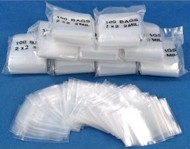 Yep, you read that right… zipper-type plastic bags. As mentioned in a previous article, in some cases the metal used in a coin is worth more than the coin’s face value.
Yep, you read that right… zipper-type plastic bags. As mentioned in a previous article, in some cases the metal used in a coin is worth more than the coin’s face value.
For example, all pennies 1982 to date are just copper coated zinc. BUT all pennies prior to 1982 are 95% copper and are still found commonly in pocket change. So if you do some simple math here… copper is around $2.50 a pound at present, and it takes only $1.60 worth of copper pennies to equal 1 pound. A lot of times the price of copper jumps up over $3.00 a pound — which would make copper pennies really worth double their face value or more.
I’ve found people selling $50 worth of copper pennies on eBay for $120 or more. So… pick them out of your change and throw ’em in a zip-type baggie until you amass a large quantity. Copper, silver, and gold are estimated to go up a lot over the next few years, so it might be better to just horde them for now. The government realized this was going to happen a long time ago and that people were going to start pulling coins out of circulation and hoarding them. That’s why in 1982 they changed the composition to copper-coated zinc.
Check out these silver & metal content calculators to see what the value of your coin is — melted. (Scroll to the very bottom.)
Oh, And There’s One More Coin Storage Option…
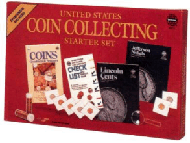 If you’ve just recently started to collect coins, Whitman makes a coin starter set that you might want to try.
If you’ve just recently started to collect coins, Whitman makes a coin starter set that you might want to try.
It’s just a small kit for beginners that comes with a few 2×2 holders, some mylar flips, coin tubes, an album, a small magnifier, etc.

